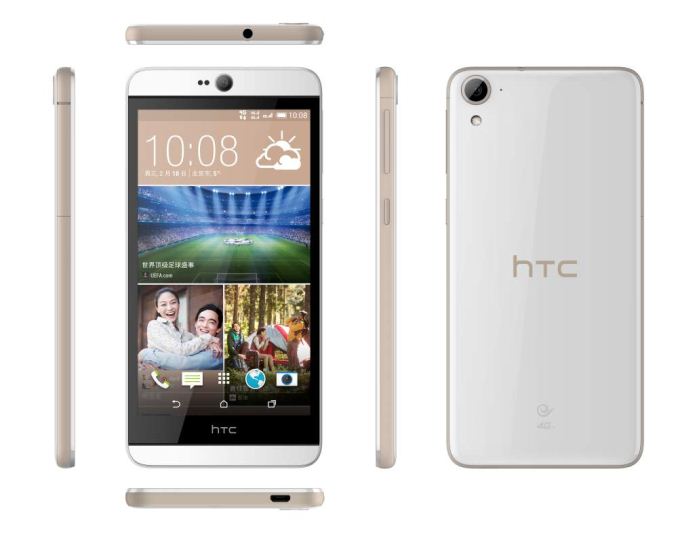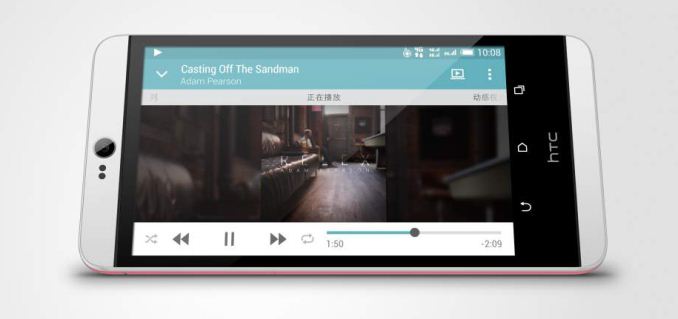HTC Announces the Desire 826
by Brandon Chester on January 6, 2015 4:17 PM EST- Posted in
- Smartphones
- HTC
- CES 2015
- Desire 826

Yesterday at CES, HTC announced the newest device in their lineup of Desire smartphones. Years ago, HTC's flagship devices fell under the Desire brand. In recent years, the Desire brand has been shifted to more budget oriented devices. This new HTC smartphone is the Desire 826, and it follows in the footsteps of the Desire 816 and Desire 820 that came before it. Although it isn't HTC's flagship smartphone, it still has respectable specifications, and in many ways is not far off from today's flagship devices. I've laid out the key specifications of the Desire 826 below.
| HTC Desire 826 | ||||||
| SoC | Qualcomm Snapdragon 615, 4 x Cortex A53 at 1.7GHz + 4 x Cortex A53 at 1.0GHz, Adreno 405 GPU |
|||||
| Memory and Storage | 16GB NAND + MicroSDXC, 2GB LPDDR3 | |||||
| Display | 5.5” 1920x1080 LCD | |||||
| Cellular Connectivity | 2G / 3G / 4G LTE (Qualcomm MDM9x25 UE Category 4 LTE) | |||||
| Dimensions | 158 x 77.5 x 7.99 mm, 183g | |||||
| Camera | 13 MP f/2.2 Rear Facing, 4MP UltraPixel f/2.0 Front Facing or 13MP f/2.0 Front Facing | |||||
| Battery | 2600 mAh (9.88 Whr) | |||||
| Other Connectivity | 802.11 a/b/g/n + BT 4.1, AptX, USB2.0, GPS/GNSS, NFC (in select regions) | |||||
| SIM Size | Nano SIM (Dual SIM SKU available) | |||||
| Operating System | Android 5.0 Lollipop with HTC Sense | |||||
The Desire 826 has a lot in common with the Desire 820 that was released in September 2014. Both devices use Qualcomm's Snapdragon 615 with 2GB of LPDDR3 memory, 16GB of NAND, and 2600mAh (9.88Wh) battery. However, the Desire 826 has a maximum clock speed of 1.7GHz on its high-power A53 cluster, while the Desire 820 was limited to 1.5GHz. Being an Android 5.0 Lollipop device, the Desire 826 will also be 64-bit enabled out of the gate, while the Desire 820 had to operate in 32-bit mode due to a 64-bit version of Android being unavailable. I still believe having two clusters of Cortex-A53s is silly, but HTC weren't the ones making that decision so it's not something I can really fault the phone itself for.
There are some other notable improvements over the Desire 820. The Desire 826 has a significantly sharper display due to HTC's move from 1280x720 to 1920x1080 on the same panel size. The front-facing camera is the other significant difference between the two devices. While the Desire 820 used an 8MP front-facing sensor, the Desire 826 uses a 4MP UltraPixel sensor with an f/2.0 aperture for the front-facing camera in most markets. This should significantly improve low-light camera performance. In certain unspecified markets, the Desire 826 will use a 13MP f/2.0 sensor instead. Like all of HTC's recent devices, the Desire 826 ships with HTC's Eye Experience software for the camera.
The Desire 826 will be available in the Asia-Pacific region by the end of this month, and will expand to other markets afterward. It comes in multiple colors, including but not limited to white, purple, and blue. There is currently no word on what to expect for pricing, but it should be similar to the launch price of the Desire 820.
Source: HTC











40 Comments
View All Comments
MrSpadge - Tuesday, January 6, 2015 - link
An A53 cluster is pretty small, so having a low power one as a "little" configuration is nice. But using 4 A53 as BIG cluster is just plain stupid, 2 A57 would be a far better choice. They'd be significantly faster most of the time and in contrast to a cluster of 4 A57 one could actually use their frequency headroom in a phone.aryonoco - Tuesday, January 6, 2015 - link
Well 2x A57 + 4x A53 is probably ideal for this market, but it doesn't really exist yet. That's Qualcomm SD 808, stated to be available in Q2 this year. So right now, HTC uses what's available, and that's SD 615.As as someone else mentioned, the Asia Pacific region wants more cores, so that's what the Asia Pacific region gets. HTC tried its hand at "educating consumers" with the UltraPixel fiasco. It flopped massively in Asia. I don't blame a company that tries to ride the wave instead of swimming against it, when every other company does the same (bar Apple, which really is its own market).
extide - Tuesday, January 6, 2015 - link
The only problem with the SD 808 is the compromised GPU. If they made a 2xA57 + 4xA53 with the top end GPU, that would be awesome! Heck, I bet even a 2+2 setup would be fine.MrSpadge - Wednesday, January 7, 2015 - link
Good point about SD 808 not being available yet. And I agree, 2+2 A53/A57 sounds ideal for a phone to me. Although 4+2 would have an advantage in some applications if all cores could be used at once. Like running a highly threaded load on all low power cores and the high power cores at "medium throttle", whatever still fits the power limit. In such cases efficiency should be better than simply running the big cores at full throttle.But regarding the GPU: is the GPU really limiting you in what you can do with your phone?
tuxRoller - Saturday, January 10, 2015 - link
They can, and will, all be used at once.Global Task Switching.
The problem is deciding which processes to run on which cores. It's an ongoing issue, one that no one has solved for arbitrary loads, but it's being worked on.
StormyParis - Tuesday, January 6, 2015 - link
The whole point of big.LITTLE is that you've got the same number of big and little cores, which makes switching easier.Wilco1 - Wednesday, January 7, 2015 - link
No, big.LITTLE does not require the same number of big and little cores. With global task switching you can run all cores simultaneously if required.tuxRoller - Saturday, January 10, 2015 - link
To elaborate on what wilco1 has said, big.LITTLE is about matching load to cores, and, in turn, minimizing power draw. big.LITTLE allows for a larger dynamic range of loads than any individual core, and provides lower latency core transitions than with dvfs (although they obviously use dvfs as well).The hardware is now available, and, in the future, you should see even larger differences between big.LITTLE archs as the big cores become increasingly OoO. The software, however, is not yet where it needs to be in order to best take advantage of big.LITTLE. It's a very hard problem.
saratoga4 - Tuesday, January 6, 2015 - link
4 A53s are much cheaper than 2 A57s. Remember, this is a midrange to budget part.Vegator - Saturday, January 10, 2015 - link
That's the key point. Four Cortex-A53 cores are much cheaper, much smaller (in terms of die size) and more power efficient than two A57 cores. And when clocked at speeds of 1.7 GHz or higher, even single-core performance is quite acceptable (about two times that of Snapdragon 400, and not that far from Snapdragon 801).Just the inclusion of Cortex-A57 cores on a chip increases cost and power/heat management requirements significantly. That can make the difference between a device that costs $200 to make (with Cortex-A57 cores) vs. one that costs below $100 (for example, Snapdragon 615, just Cortex-A53 cores, 32-bit memory interface etc).
I expect even high-end devices with eight Cortex-A53 cores clocked at a high frequency to be competitive, especially because of reduced cost and low power. There are also indications that Cortex-A53 is scaling much better on newer processes than Cortex-A57 (more gains on power efficiency and performance when going from 28nm to 20nm, for example). That should be apparent when 20nm parts with just Cortex-A53 cores appear on the market.